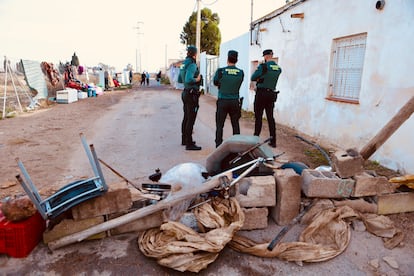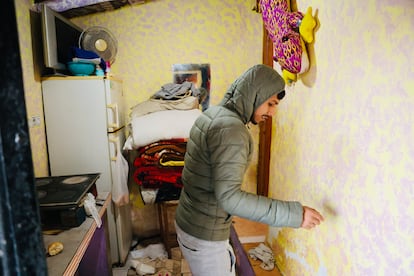Uncertainty and fear after the eviction of a shanty town in Níjar: “What are we going to do now?”

With a serious face, tired from spending the night practically without sleep, Mehdi, a 23-year-old Moroccan, watches as an excavator approaches the place where he lives. “What are we going to do now?” he asks himself, aware that his shack, one of the ten that there are on the grounds of the El Uno farmhouse, in the municipality of Níjar (Almería) , is about to be demolished by court order . Around him, his neighbours take out into the street the few belongings they have left in the old warehouse that they share with other families. On a fence there are blankets, fridges, fans, bags of clothes, a Moroccan national team shirt. And a bicycle belonging to one of the nine minors who live in this settlement, which on Tuesday morning received, punctually, at 9.40 am, the visit of the judicial delegation that has notified the eviction with the protection of a large force of Civil Guard and Local Police. The officers were watching to make sure that no one was stopping the pickaxes from demolishing these slums built from pallets and plastic, a job that began shortly before eleven in the morning.
The Court of First Instance number 1 of Almería ordered the eviction of this shanty town at the beginning of the month, made up of a handful of shacks, an old farmhouse divided into small half-demolished houses and an old industrial warehouse. “No to eviction,” read a graffiti written on one of the facades built with concrete blocks. On its door, just a sheet hanging from a rope, there was a scooter with two suitcases. It is all that one of the women who live in this corner next to the San Isidro neighbourhood surrounded by greenhouses could carry. Many of the inhabitants of El Uno work in them. “Tomatoes, peppers, courgettes,” Mehdi emphasises. “We do seasonal work, what we can,” adds his friend Maati. “We don’t know where to go,” added the young man, aged 27 and who has been employed intermittently in intensive agriculture for five years. Like them, 3,500 other people live in 30 similar camps in the Níjar region. The largest of these, Atochares, houses more than 500 migrants.
Early in the morning, oblivious to everything, a two-and-a-half-year-old boy tried to get around on a small plastic bicycle. “The rest of the children are already at school,” explained Fouciya, a woman in her thirties who was not sure what to do with her life or where to sleep tonight. Around her, minutes before eight o’clock, a group of activists were busy setting up three rudimentary barricades with old electrical appliances, bricks and various objects. Several of these volunteers spent the night in the settlement helping the residents, who had already been carrying out loads since Monday to remove their few possessions from what have been their homes for years. “We don’t know where to go. We have been looking for a home for weeks, but there is nothing to rent. And if you don’t have papers, it is much more complicated,” added Abdoul, 33 years old.

At around eleven o'clock, under the orders of the Civil Guard and the watchful eyes of the residents, an excavator began to demolish the first shacks, whose inhabitants had been notified of the eviction by the judicial committee minutes before. The blows of the pickaxe easily knocked down the wooden and plastic structures. "It is an unjust and inhuman act," denounced the social organisations, unions and political parties that make up the platform Derecho a Techo, which criticises the passivity of the administrations and also of the agricultural employers. "All they have left is the ground to sleep on," stressed activist Ricardo Pérez.
Some have found a place in the home of a relative, others plan to rebuild their shack in nearby camps. Several have travelled to Murcia in search of another opportunity and there is even a family that has decided to return to Morocco. Only half a dozen of them will be taken in by Almería Acoge and some more by other social organisations. The majority, however, are left on the streets. “People are trying to make a living. In reality, most of them have nowhere to go. It is a very traumatic situation to see how the lives and homes of these people are destroyed. And even worse is doing so with the helplessness of seeing that there is no alternative, that no one has offered them a solution,” emphasises Daniel Izuzquiza, head of the Jesuit Migrant Service (SJM) who has been working in the area with migrants for four years. “The fact is that there are many people, between 50 and 60, including nine minors, who are going to be left on the streets in a state of helplessness. And the public administrations have not given the appropriate response or what the law requires of them. First the City Council, then the Andalusian Regional Government, and then successively they have the obligation to defend the rights of people in vulnerable situations, especially children," insisted Izuzquiza, who also mentioned the report of the Andalusian Ombudsman that this Monday asked the Níjar City Council to act "urgently and preferentially."
The report, sent to the mayor of Níjar, José Francisco Garrido (PP) and signed by the defender, Jesús Maeztu, asked the municipality to assess the vulnerable situation of the residents of the El Uno farm, to coordinate with other administrations so that they are not left on the street “prioritizing families with minors” and to channel their resources with the help of social organizations that work in the region. Sources from the council have insisted in recent days that the eviction was a “private matter” in which they had no responsibility or competence. “There are no homes,” they excused themselves for not proposing solutions to the families evicted this Tuesday, although in the area of Los Grillos there are 62 that are already ready and specifically aimed at field workers in the area of Los Grillos are waiting for “a transfer” to be managed “by an entity,” according to the councilor for Social Services, Ángeles Góngora. Lifting them cost two million euros. And although they have been equipped for months, they are still empty. This is the fourth settlement to be demolished since February 2023 after those known as Walili, Megasa and Cañaveral (the only one with relocation options before demolition), all in the area surrounding San Isidro.

EL PAÍS






